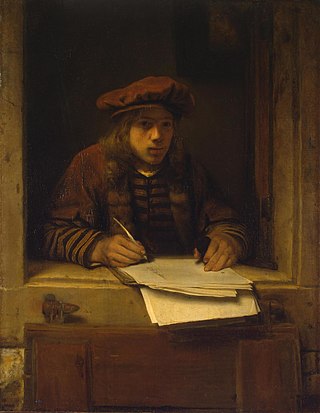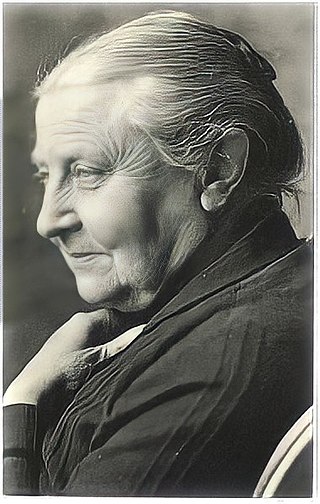
Goirle is a municipality and town in the southern Netherlands, in the province of North Brabant. Part of the suburban area of the city of Tilburg, it shares with it its phone area code and public transport system.
Antonius is a masculine given name, as well as a surname. Antonius is a Danish, Dutch, Finnish, Latin, Norwegian, and Swedish name used in Greenland, Denmark, Norway, Sweden, Finland, part of the Republic of Karelia, Estonia, Belgium, Netherlands, Suriname, South Africa, Namibia, and Indonesia, while Antoníus is an Icelandic name used in Iceland. It is also the source of the English personal name Anthony, as well as a number of similar names in various European languages.
Dutch language literature comprises all writings of literary merit written through the ages in the Dutch language, a language which currently has around 23 million native speakers. Dutch-language literature is the product of the Netherlands, Belgium, Suriname, the Netherlands Antilles and of formerly Dutch-speaking regions, such as French Flanders, South Africa, and Indonesia. The Dutch East Indies, as Indonesia was called under Dutch colonization, spawned a separate subsection in Dutch-language literature. Conversely, Dutch-language literature sometimes was and is produced by people originally from abroad who came to live in Dutch-speaking regions, such as Anne Frank and Kader Abdolah. In its earliest stages, Dutch-language literature is defined as those pieces of literary merit written in one of the Dutch dialects of the Low Countries. Before the 17th century, there was no unified standard language; the dialects that are considered Dutch evolved from Old Frankish. A separate Afrikaans literature started to emerge during the 19th century, and it shares the same literary roots as contemporary Dutch, as Afrikaans evolved from 17th-century Dutch. The term Dutch literature may either indicate in a narrow sense literature from the Netherlands, or alternatively Dutch-language literature.

Samuel Dirksz van Hoogstraten was a Dutch painter of the Golden Age, who was also a poet and author on art theory.

The Leeuwarder Courant is the oldest daily newspaper in the Netherlands. Founded by Abraham Ferwerda, it first appeared in 1752. The Leeuwarder Courant was the first paper in the Dutch province Friesland and its capital Leeuwarden. It is considered a "popular" newspaper.

Jacob van Lennep was a Dutch poet and novelist.

The Hague School is a group of artists who lived and worked in The Hague between 1860 and 1890. Their work was heavily influenced by the realist painters of the French Barbizon school. The painters of the Hague school generally made use of relatively somber colors, which is why the Hague School is sometimes called the Gray School.

The Royal Library of the Netherlands is the national library of the Netherlands, based in The Hague, founded in 1798. The KB collects everything that is published in and concerning the Netherlands, from medieval literature to today's publications. About 7 million publications are stored in the stockrooms, including books, newspapers, magazines and maps. The KB also offers many digital services, such as the national online Library, Delpher and The Memory. Since 2015, the KB has played a coordinating role for the network of the public library.
Flemish literature is literature from Flanders, historically a region comprising parts of present-day Belgium, France and the Netherlands. Until the early 19th century, this literature was regarded as an integral part of Dutch literature. After Belgium became independent from the Netherlands in 1830, the term Flemish literature acquired a narrower meaning and refers to the Dutch-language literature produced in Belgium. It remains a part of Dutch-language literature.

Dutch art describes the history of visual arts in the Netherlands, after the United Provinces separated from Flanders. Earlier painting in the area is covered in Early Netherlandish painting and Dutch and Flemish Renaissance painting.

Joris Mathijsen is a Dutch former professional footballer who played as a centre-back. He is the director of football at Willem II.
Dirk, Count van Hogendorp, son of Gijsbert Karel van Hogendorp, nephew of Dirk van Hogendorp, father of Dirk van Hogendorp jr., was a Dutch jurist. Van Hogendorp lived continually in the shadow of his father, the founder of the first Dutch Constitution. He is a great-great-grandfather of Audrey Hepburn.

The Burgundian language, also known by French names Bourguignon-morvandiau,Bourguignon, and Morvandiau, is an Oïl language spoken in Burgundy and particularly in the Morvan area of the region.
Javanese literature is, generally speaking, literature from Java and, more specifically, from areas where Javanese is spoken. However, similar with other literary traditions, Javanese language works were and not necessarily produced only in Java, but also in Sunda, Madura, Bali, Lombok, Southern Sumatra and Suriname. This article only deals with Javanese written literature and not with oral literature and Javanese theatre such as wayang.

Antonius Mathijsen was a Dutch army surgeon who first used plaster of Paris to fixate broken bones in a plaster cast.
The Huizinga Lecture is an annual lecture in the Netherlands about a subject in the domains of cultural history or philosophy. The lecture is in honour of Johan Huizinga, a distinguished Dutch historian (1872–1945) who worked in the first half of the 20th century. The Lecture is organized by nationwide daily general newspaper NRC Handelsblad, the Faculty of Humanities of Leiden University, and the Maatschappij der Nederlandse Letterkunde. Attendance at the lecture was free of charge for subscribers to NRC Handelsblad, members of the Faculty of Humanities, and members of the Maatschappij der Nederlandse Letterkunde until 2010. From 2011 onwards tickets have to be bought. The lecture is held alternately by a Dutch and a non-Dutch intellectual.

Marie-Elisabeth Belpaire was a Belgian writer and activist. She was known as the "mother of the Flemish Movement".
Kathleen Vereecken is a Belgian writer of novels, children's literature and non-fiction.

Estella Dorothea Salomea Hijmans-Hertzveld was a Dutch poet, translator, and activist. From a young age, her poems, mainly on Biblical and historical themes, appeared regularly in respectable literary journals. Frequently, her work also addressed contemporary social issues, including the abolition of slavery, Jewish emancipation, and opposition to war. A collection of her best-known poems, entitled Gedichten ('Poems'), was published several weeks before her death in 1881.

The statue of Kwakoe in the Surinames capital Paramaribo is a monument commemorating the abolition of slavery. It was made by the sculptor Jozef Klas.













